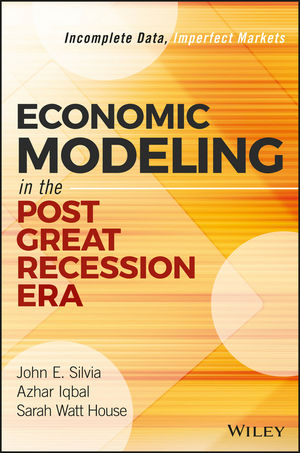
Economic Modeling in the Post Great Recession Era
John Wiley & Sons Inc (Verlag)
978-1-119-34983-9 (ISBN)
Reality-based modeling for today's unique economic recovery Economic Modeling in the Post Great Recession Era presents a more realistic approach to modeling, using direct statistical applications to address the characteristics and trends central to current market behaviors. This book's unique focus on the reality of today's markets makes it an invaluable resource for students and practitioners seeking a comprehensive guide to more accurate forecasting. While most books treat the economy as if it were in a vacuum, building models around idealized or perception-biased behaviors, this book deals with the economy as it currently stands—in a state of recovery, limited by financial constraints, imperfect information, and lags and disparities in price movements. The authors identify how these characteristics impact various markets' behaviors, and quantify those behaviors using SAS as the primary statistical tool.
Today's economy bears a number of unique attributes that usual modeling methods fail to consider. This book describes how to approach modeling based on real-world, observable data in order to make better-informed decisions in today's markets.
Discover the three economic characteristics with the greatest impact on various markets
Create economic models that mirror the current post-recession reality
Adopt statistical methods that identify and adapt to structural breaks and lags
Factor real-world imperfections into modeling for more accurate forecasting
The past few years have shown a clear demarcation between policymakers' forecasts and actual outcomes. As the dust settles on the Great Recession, after-effects linger—and impact our current recovery in ways that diverge from past experience and theoretical expectations. Economic Modeling in the Post Great Recession Era provides comprehensive guidance grounded in reality for today's economic decision-makers.
JOHN E. SILVIA is a managing director and the chief economist for Wells Fargo. Previously he worked on Capitol Hill as senior economist for the U.S. Senate Joint Economic Committee and chief economist for the U.S. Senate Banking, Housing, and Urban Affairs Committee. AZHAR IQBAL is director and econometrician at Wells Fargo Securities. SARAH WATT HOUSE is vice president of Wells Fargo Securities.
Preface/Justification xiii
Acknowledgments xxi
Chapter 1 Setting the Context 1
The Problem with Uncritical Assumptions in a Less-Than-Perfect Economy 2
The Problem with Models in an Imperfect Economy 3
Four Characteristics of a Less-Than-Perfect Economy 4
Economic Policy Inconsistencies—The Parable of Strange Bedfellows 13
Chapter 2 Dynamic Adjustment in an Economy: Frictions Matter 15
Introduction 16
Quantifying Frictions: Is the Long-Run Average a Useful Guide for the Future? 32
Modeling Dynamic Adjustment due to Economic Frictions: Decision Making in an Evolving World 49
Dynamic Economic Adjustment: An Evolution unto Itself 67
Appendix 68
A Case for the Multiple Markets: 1983–2008 68
The Labor Market: 1983–2008 70
Chapter 3 Information: Past Imperfect, Present Incomplete, Future Uncertain 73
Story Behind the Numbers 76
Conclusion 103
Chapter 4 Price Adjustment and Search for Equilibrium 105
What Barriers Are There to Perfectly Flexible Prices? 107
Implications 112
Finding Dynamic Adjustment in the Data 116
Conclusion 121
Chapter 5 Business Investment: This Time Is Different 123
Drivers of Business Spending 125
Putting It All Together: Explaining Slow Recovery in Capital Investment 134
Chapter 6 Corporate Profits: Reward, Incentive, and That Standard of Living 135
Introduction: Profits as Essential Partner 136
The Role of Profits in the Economic Cycle: Five Drivers 137
The Role of Profits: Incentives and Rewards 140
Concluding Remarks: Modeling Profits 167
Chapter 7 Labor Market Evolution: Implications for Private-Sector and Public-Policy Decision Makers 169
Part I: Labor Market Imperfections 171
Part II: Heterogeneity in the Labor Market 182
Part III: How Do Secular Labor Market Trends Impact Economic Policy? 196
Chapter 8 Inflation: When What You Get Isn’t What You Expect 205
Introduction 206
What Is Inflation? 207
Why Does Inflation Matter? 208
What Determines Inflation? 212
Inflation after the Great Recession 219
Application: Predicting if Central Banks Can Achieve Price Stability 230
Chapter 9 Interest Rates and Credit: Capital Markets in the Post–Great Recession World 235
Imperfect Guidance in an Uncertain World 236
A Look at Actual History over the Long Run 247
Credit and Administered Rates 250
Imperfect Information and Credit 255
Conclusion: Shift from Historical Benchmarks 280
Chapter 10 Three-Dimensional Checkers: Open Economy, Capital Flows, and Exchange Rates 281
Newton’s Third Law 282
Introducing a New Price to the Analysis: The Role of Exchange Rates 289
Three-Dimensional Checkers on an International Playing Field 295
A Perfect Model in an Imperfect World 298
Concluding Remarks: Future Looks Different 330
Chapter 11 Assessing Economic Policy in an Imperfect Economy 331
Generalized Policy Model 333
Rules and Reputation: Beyond Economic Benchmarks 338
Confronting Our Three Market Imperfections 340
Economic Policy in the Context of an Imperfect Economy 359
About the Authors 361
Index 363
| Erscheinungsdatum | 26.01.2017 |
|---|---|
| Reihe/Serie | SAS Institute Inc |
| Verlagsort | New York |
| Sprache | englisch |
| Maße | 163 x 231 mm |
| Gewicht | 544 g |
| Themenwelt | Geschichte ► Teilgebiete der Geschichte ► Wirtschaftsgeschichte |
| Wirtschaft ► Volkswirtschaftslehre ► Finanzwissenschaft | |
| Wirtschaft ► Volkswirtschaftslehre ► Ökonometrie | |
| ISBN-10 | 1-119-34983-4 / 1119349834 |
| ISBN-13 | 978-1-119-34983-9 / 9781119349839 |
| Zustand | Neuware |
| Haben Sie eine Frage zum Produkt? |
aus dem Bereich


